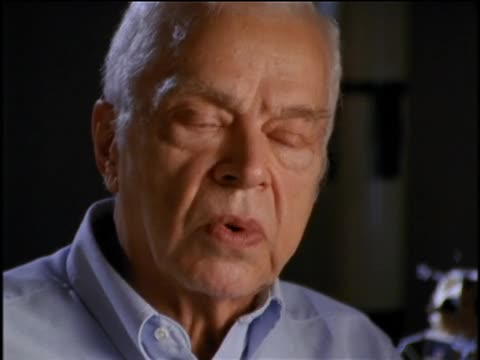NOVA; To the Moon; Interview with John Cornelius Houbolt, aerospace engineer behind the Lunar Orbit Rendezvous (LOR), part 1 of 4
- Series
- NOVA
- Episode
- To the Moon
- Producing Organization
- WGBH Educational Foundation
- Contributing Organization
- WGBH (Boston, Massachusetts)
- AAPB ID
- cpb-aacip-15-sn00z72b6g
If you have more information about this item than what is given here, or if you have concerns about this record, we want to know! Contact us, indicating the AAPB ID (cpb-aacip-15-sn00z72b6g).
- Description
- Program Description
- This remarkably crafted program covers the full range of participants in the Apollo project, from the scientists and engineers who promoted bold ideas about the nature of the Moon and how to get there, to the young geologists who chose the landing sites and helped train the crews, to the astronauts who actually went - not once or twice, but six times, each to a more demanding and interesting location on the Moon's surface. "To The Moon" includes unprecedented footage, rare interviews, and presents a magnificent overview of the history of man and the Moon. To the Moon aired as NOVA episode 2610 in 1999.
- Raw Footage Description
- John Cornelius Houbolt, aerospace engineer behind the Lunar Orbit Rendezvous (LOR) is interviewed about engineering the spacecraft for Apollo and the LOR. Houbolt describes his start with the Apollo program, and why the NOVA rocket had to be so large, using a chart comparing the sizes of various manned spacecraft. He also discusses the impracticality of the NOVA rocket and explains the benefits of the LOR mode as leaving the living room (the command space module) in space rather than bringing the living room all the way down to the moon with you. Houbolt also mentions his belief that a direct descent to the moon would not have worked, and explains the many problems with doing Earth Orbit Rendezvous, using a chart. Houbolt also explains how he came up with the idea for the LOR, its benefits, his minority report on the LOR, and the initial reactions to the use of LOR. The LOR was initially rejected, and Houbolt explains the benefits and drawbacks of "direct descent", and his confidence in the safety of the rendezvous.
- Created Date
- 1998
- Asset type
- Raw Footage
- Genres
- Interview
- Topics
- History
- Technology
- Science
- Subjects
- American History; Gemini; apollo; moon; Space; astronaut
- Media type
- Moving Image
- Duration
- 00:23:13
- Credits
-
-
Interviewee: Houbolt, John Cornelius, 1919-2014
Producing Organization: WGBH Educational Foundation
- AAPB Contributor Holdings
-
WGBH
Identifier: cpb-aacip-919d6b8937f (Filename)
Format: Digital Betacam
Generation: Original
Duration: 0:23:13
If you have a copy of this asset and would like us to add it to our catalog, please contact us.
- Citations
- Chicago: “NOVA; To the Moon; Interview with John Cornelius Houbolt, aerospace engineer behind the Lunar Orbit Rendezvous (LOR), part 1 of 4 ,” 1998, WGBH, American Archive of Public Broadcasting (GBH and the Library of Congress), Boston, MA and Washington, DC, accessed December 19, 2025, http://americanarchive.org/catalog/cpb-aacip-15-sn00z72b6g.
- MLA: “NOVA; To the Moon; Interview with John Cornelius Houbolt, aerospace engineer behind the Lunar Orbit Rendezvous (LOR), part 1 of 4 .” 1998. WGBH, American Archive of Public Broadcasting (GBH and the Library of Congress), Boston, MA and Washington, DC. Web. December 19, 2025. <http://americanarchive.org/catalog/cpb-aacip-15-sn00z72b6g>.
- APA: NOVA; To the Moon; Interview with John Cornelius Houbolt, aerospace engineer behind the Lunar Orbit Rendezvous (LOR), part 1 of 4 . Boston, MA: WGBH, American Archive of Public Broadcasting (GBH and the Library of Congress), Boston, MA and Washington, DC. Retrieved from http://americanarchive.org/catalog/cpb-aacip-15-sn00z72b6g
